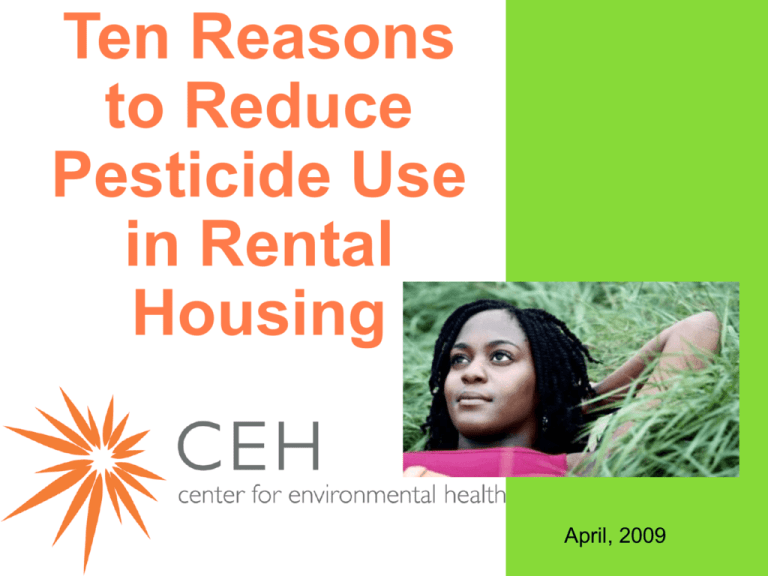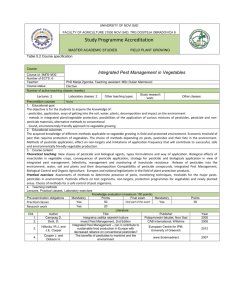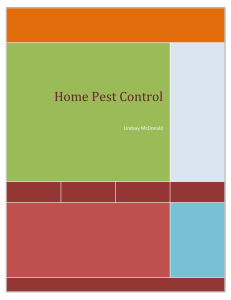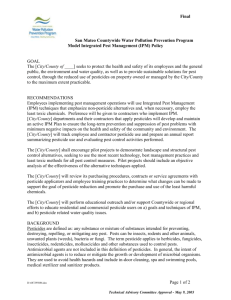here - Center for Environmental Health
advertisement

Ten Reasons to Reduce Pesticide Use in Rental Housing April, 2009 1. Pesticides are hazardous to human health. Common insecticides with EPA-identified cancer concerns bifenthrin possible human carcinogen cypermethrin possible human carcinogen fipronil possible human carcinogen malathion suggestive evidence of carcinogenicity permethrin likely to be carcinogenic to humans piperonyl butoxide (synergist) possible human carcinogen U.S. Environmental Protection Agency. 2008. Chemicals evaluated for carcinogenic potential. http://envirocancer.cornell.edu/turf/chemseval.pdf. Common insecticides with NIOSH-identified concerns about reproductive harm cypermethrin reduced male fertility; birth defects deltamethrin reduced newborn survival; birth defects fipronil effects on newborn behavior imidacloprid miscarriages; birth defects permethrin reduced fertility; reduced newborn survival National Institute for Occupational Safety and Health. 2008. Registry of Toxic Effects of Chemical Substances. http://www.cdc.gov/niosh/rtecs/gz1312d0.html; http://www.cdc.gov/niosh/rtecs/gz12d068.html; http://www.cdc.gov/niosh/rtecs/uq4399aa.html; http://www.cdc.gov/niosh/rtecs/nj88b80.html; http://www.cdc.gov/niosh/rtecs/gz132658.html. 2. Pesticides cause special problems for children. For their size, children drink more water and eat more food than adults do. Their play exposes them to pesticides. Exposure to a common insecticide 2-phenoxybenzoic acid (micrograms per liter) 0.3 0.2 0.1 0 children adults Centers for Disease Control and Prevention. 2005. Third National Report on Human Exposure to Environmental Chemicals. http://www.cdc.gov/ExposureReport/pdf/thirdreport.pdf. 3. Pesticides often contaminate food. Common insecticides found by USDA on common food items 72% of broccoli samples contaminated with imidacloprid 39% of frozen potato samples contaminated with imidacloprid 45% of cherry samples contaminated with bifenthrin 21% of celery samples contaminated with malathion 46% of celery samples contaminated with permethrin U.S. Dept. of Agriculture. Agricultural Marketing Service. Science and Technology Programs. 2008. Pesticide Data Program: Annual Summary, Calendar Year 2007. www.ams.usda.gov/pdp. 4. Pesticides are particularly hazardous for pesticide applicators. Agricultural Health Study Sponsored by the National Cancer Institute, the National Institute of Environmental Health Sciences, and the Environmental Protection Agency Linked to pesticide use: • cancer • depression • retinal degeneration • neurological problems • asthma and other breathing problems • diabetes http://aghealth.nci.nih.gov/ 5. Pesticides are hazardous to pets. “We looked over the U.S. EPA's database of reported incidents involving domestic animals, from all products containing pyrethrins and pyrethroids. We found numerous cases of animals whose skin was burned, animals that had seizures and vomiting. We found tens of thousands of reported incidents, including thousands of deaths.” Joel Grover and Matt Goldberg.NBC-Los Angeles. 2009. Pet Products Investigation. Mar 24. http://www.nbclosangeles.com/news/local/Pet_Products_Concern.html. 6. Pesticides contaminate water and air. Common insecticides in a survey of 30 California streams bifenthrin - 100% cyfluthrin - 97% permethrin 53% Robert W. Holmes et al. 2008. Statewide Investigation of the Role of Pyrethroid Pesticides in Sediment Toxicity in California’s Urban Waterways. Environ. Sci. Technol. 42 (18): 7003-7009. 7. Pesticides are hazardous to fish and birds. cypermethrin “For freshwater fish, invertebrates, and estuarine/marine fish, invertebrates, technical grade cypermethrin is very highly toxic on an acute basis.” --U.S. EPA deltamethrin “moderately to highly toxic to fish” --National Pesticide Information Center fipronil “highly toxic to bobwhite quail and pheasants” “highly to very highly toxic to marine and freshwater fish” --National Pesticide Information Center imidacloprid “highly toxic to the house sparrow, moderately toxic to upland game birds” --National Pesticide Information Center malathion “considered moderate to very high in toxicity to fish” --National Pesticide Information Center permethrin “highly toxic to both freshwater and estuarine aquatic organisms” --U.S. Environmental Protection Agency 8. Pesticide health and safety testing is conducted by pesticide manufacturers. 9. Pesticides have too many secrets. 10. Pesticides don’t solve pest problems. Solving a pest problem means changing the conditions that allow a pest to thrive. Definition of “Integrated Pest Management” in California law Healthy Schools Act of 2000 (Assembly Bill 2260) "…a pest management strategy that focuses on long-term prevention or suppression of pest problems through a combination of techniques such as monitoring for pest presence and establishing treatment threshold levels, using nonchemical practices to make the habitat less conducive to pest development, improving sanitation, and employing mechanical and physical controls. Pesticides that pose the least possible hazard and are effective in a manner that minimizes risks to people, property, and the environment, are used only after careful monitoring indicates they are needed according to preestablished guidelines and treatment thresholds." Percentage of apartments with cockroaches Successful IPM in New York City apartments 90 80 70 60 50 40 30 20 10 0 IPM No IPM No IPM IPM start of study end of study Barbara L. Brenner et al. 2003. Integrated Pest Management in an Urban Community: A Successful Partnership for Prevention. Environ Health Perspect 111:1649–1653. Costs of successful IPM “The costs of adopting buildingwide IPM in a typical East Harlem apartment building were calculated to be $46–69 per unit in the first year (including repairs) and $24 per unit per year in subsequent years. In comparison, the costs of traditional, chemically based pest control are estimated to be $24–46 per unit per year.” Barbara L. Brenner et al. 2003. Integrated Pest Management in an Urban Community: A Successful Partnership for Prevention. Environ Health Perspect 111:1649–1653. Reducing pesticide use is good for tenants, good for property managers, and good for the environment. Caroline Cox caroline@ceh.org







